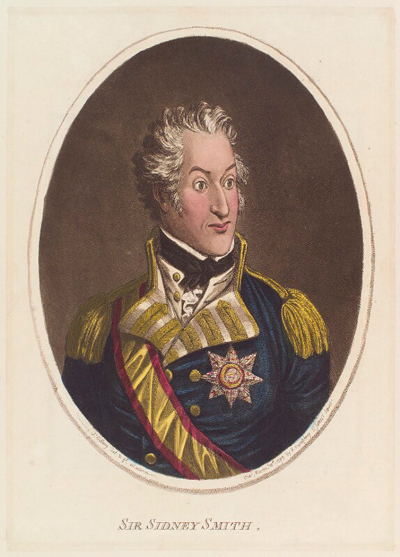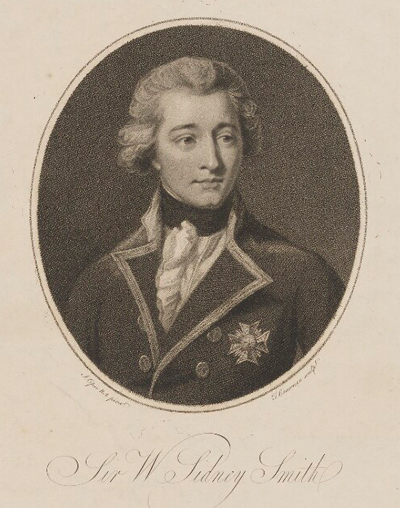Sir Sidney Smith
The immediate occasion for this "serious" celebrity portrait of Sir Sidney Smith was the defeat of Napoleon at St. Jean d'Acre after a French siege of almost two months from March 20 to May 21, 1799. Smith played such a major role in that defeat that even twenty years later Napoleon is said to have been unable to bear the mention of his name.

© National Portrait Gallery, London
Hearing of Napoleon's gruesome victories at El Arish and Jaffa and anticipating his attack on the port and medieval fortress held by Djezzar Pacha at St. Jean d'Acre, Smith had immediately ordered one of his captains, the French nobleman and royalist Louis Edmond le Picard de Phelipaux, to set off for Acre. Once there Phelipaux helped the Pacha shore up his defense by building additional internal walls, arranging artillery for maximum effect, and training gunners. Smith himself arrived shortly thereafter just in time to intercept a French flotilla with suppplies, fresh recruits, and most importantly the siege artillery needed to attack the walled city. Smith successfully captured six of the nine French transports. For the rest of the siege, Smith was then able to use the captured artillery against the French attackers and to force the French to send any supplies slowly and painfully over the intervening desert.
Smith's reports to his superior officers over the course of the siege were regularly recorded in The London Gazette and reprinted in a variety of London newspapers throughout August and into September 1799. So when he was finally able to report Napoleon's defeat and retreat back to Cairo, Smith was regarded as a hero. Here is a newspaper account of Henry Dundas' speech about Smith delivered as the Secretary of State for War to the House of Lords on September 25, 1799.
Mr. Dundas again rose, to express the very high idea which he entertained of the merits of Sir Sidney Smith. His conduct had so far surpassed even what we are disposed to admire as great and glorious, that when he thought upon it, he was lost in wonder and astonishment. It is not more than twelve months since our eyes were turned with anxiety to the Enemy's Expedition to Egypt,—an expedition which certainly had for its ultimate object the ruin of our Eastern Possessions, and the rearing upon their wrecks the power of the Enemy. . . Sir Sidney Smith, with a mere handful of British sailors and marines, has more than surpassed our most sanguine expectations. With this comparatively insignificant force, he did not merely retreat in order and without loss before a superior Enemy, but at St. Jean D'Acre he resisted gloriously, and with success, the flower of the French Army.
London Loyd Evening Post September 25, 1799
Published within six weeks after Dundas' speech, Gillray's print was, of course, well timed to take full advantage of Smith's celebrity. Interestingly, Gillray signs the print "J. Gillray del. & ft ad vivam." which (for Gillray) usually means that it is based on a sketch taken from life. But Smith of course was far away from London in the months preceding the publication of this portrait, and Gillray's portrait looks nothing like any of the prints of Smith that would have been available to him. Where did this likelness come from? How was it possible?

Thomas Cheesman after John Opie
[May 6, 1796]
© National Portrait Gallery, London
The most likely explanation is that Gillray's sketch was made more than a year earlier in May, 1798. For this was not Sir Sidney Smith's first and only brush with fame. While attacking French ships along the coast of France in April of 1796, Sir Sidney and his Secretary, John Wright, had been captured and imprisoned at the Temple in Paris where the French King Louis XVI and his family had been held before their execution. Smith and Wright languished there for two years while numerous diplomatic efforts to free them were tried and failed. Finally, a daring plan which included the seduction of the jailer's daughter, forged papers, a timely diversion, and a succession of carriages, horses, and boats enabled Smith and Wright to make their escape and return to England in May of 1798.
Here is the account from the St James's Chronicle or British Evening Post of May 5, 1798
Finding that all hopes of an exchange were vanished, and that his confinement was likely to become more rigorous, Sir Sidney Smith determined on an escape the first favourable opportunity that offered. He had some friends at Paris, who admiring his gallantry, and commiserating his misfortunes, were anxious to effect his deliverance. It had been ordered by the Minister of Police, that he and Mr. Wright, a Gentleman taken prisoner with Sir Sidney, on board the Diamond frigate, and a partner in all his misfortunes, should be removed from the Temple prison in Paris to another jail still more common, called the General Depository. This removal was to take place on Tuesday se'nnight last, and measures were accordingly planned to effect a rescue of both these Gentlemen. On that evening they were put into a Fiacre (or Hackney Coach) accompanied by two of the Jailors. On their way to the new place of confinement a child ran across the street, and was nigh being trampled upon by the horses. At the same time there was a violent shrieking; the coach stopped, and a kind of mob instantly surrounded the carriage. The coach door was opened, and Sir Sidney and Mr. Wright escaped. A chaise was in readiness to convey them instantly out of Paris, which was done without the slightest inconvenience or bustle. They made immediately for the Coast about Havre, sending guides forward to see that all was safe. Whenever they came near posts where there were strong guards of military, called Corps de Surveillance, they either halted or took a circuitous route on foot. They were two days concealed in woods, in the neighbourhood of which was encamped a great part of the boasted [French] Army of England. After a journey of eight days, the guides conducted them very safely and skillfully to —— near Havre, where they got on board a fishing vessel, and in a few hours after they fell in with the British squadron cruising off Havre. They were taken on-board the Argo frigate, which joyfully received these welcome strangers, who on Saturday morning were landed at Portsmouth, amidst the acclamations and congratulations of all ranks of people, who lined the streets as they passed along. The same civilities were shown Sir Sidney Smith at every place where he was recognized.
Once in London Smith was introduced at Court, met with the King and the Prince of Wales, and had dinner with the Duke of Clarence. Within weeks, there were at least two different theatrical productions based on Smith's escape at Astley's Ampitheatre of Arts and at \ Sadler's Wells. Gillray could scarcely have avoided the celebration and would have had ample opporunity to take a likeness.
Draper Hill begins his commentary on this portrait by remarking upon "Gillray's singular incapacity for flattery." But if I am right that Gillray's sketch was made in May of 1798, the thin face and somewhat pained expression we see in his portrait may be the result of something other than Gillray's incapacity. In the same account of his escape, the St James's Chronicle or British Evening Post has this to say of his appearance:
The long confinement which Sir Sidney has suffered, the uncertainty of his fate, and hard living, added to his sufferings during the progress of his escape, have made a very unfavourable change in his person. His spirit, however, is unabated, and we hope that the air of Great-Britain will soon restore his health.
If Gillray made a sketch of Sir Sidney in May of 1798, why then did he sit on it for so long, and only come out with this portrait in October 1799? I can only guess that the timing wasn't right. In May of 1798, Gillray was finishing his twelve plate series of French Habits and the Irish Rebellion was beginning. Although the Smith escape was a great story and at almost any other time would have been pursued, I can only guess that Gillray may have felt that it was still a personal story and lacked national implications.
Unlike most of Gillray's prints where coloured and uncoloured versions were published the same day, the uncolored version of Sir Sidney Smith was issued October 14, 1799; the coloured version shown here is dated almost a month later on November 11. One can guess that the demand for the print and especially a coloured version must have exceeded initial expectations.
Sources and Reading
- Commentary from the British Museum on [Portrait of Sir Sidney Smith].
- Draper Hill, Mr. Gillray The Caricaturist, 1965
- Draper Hill, The Satirical Etchings of James Gillray, 1976, #67
- "Sidney Smith (Royal Navy officer)," Wikipedia
- "Siege of Acre (1799)," Wikipedia
- J. Christopher Herold, Bonaparte in Egypt, New York, 1962.
- Robert Harvey, The War of Wars, London, 2006.
Comments & Corrections
NOTE: Comments and/or corrections are always appreciated. To make that easier, I have included a form below that you can use. I promise never to share any of the info provided without your express permission.